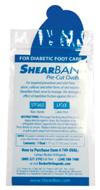We’ve made a few updates to the Tamarack website this week, including a redesign of the Tamarack Flexure Joint® and ShearBan® pages and development of a new Customer Service page. If you haven’t visited our website lately, stop by www.tamarackhti.com for product updates and fabrication resources. We invite customers to call or email us whenever you have questions or feedback about Tamarack products.
In the next month we expect to release our new black Tamarack Flexure Joints® in both the free motion and dorsiflexion assist models (not including pediatric size joints). The black color option was developed to create a more cosmetically appealing finish when Tamarack Flexure Joints are installed in carbon fiber or dark thermoplastic orthoses. Stay tuned for more information.
If you didn’t get a chance to stop by our booth at the American Orthotic and Prosthetic Association Annual Meeting earlier this month, you probably aren’t aware of our new solution for creating perfect flexure joint cavities, the Tamarack Retrofit Cap™. We developed this product to facilitate easier, more precise and cost-saving installation of Tamarack Flexure Joints in carbon fiber laminations. The product can also be added to solid ankle orthoses – either custom or off-the-shelf, effectively creating an articulating brace in far less time than fabricating a new device. If you’d like more information about the Tamarack Retrofit Cap – or to be notified when it becomes available from your O&P component supplier, email Tamarack Sales & Marketing.
Have a safe & enjoyable Halloween weekend!




















